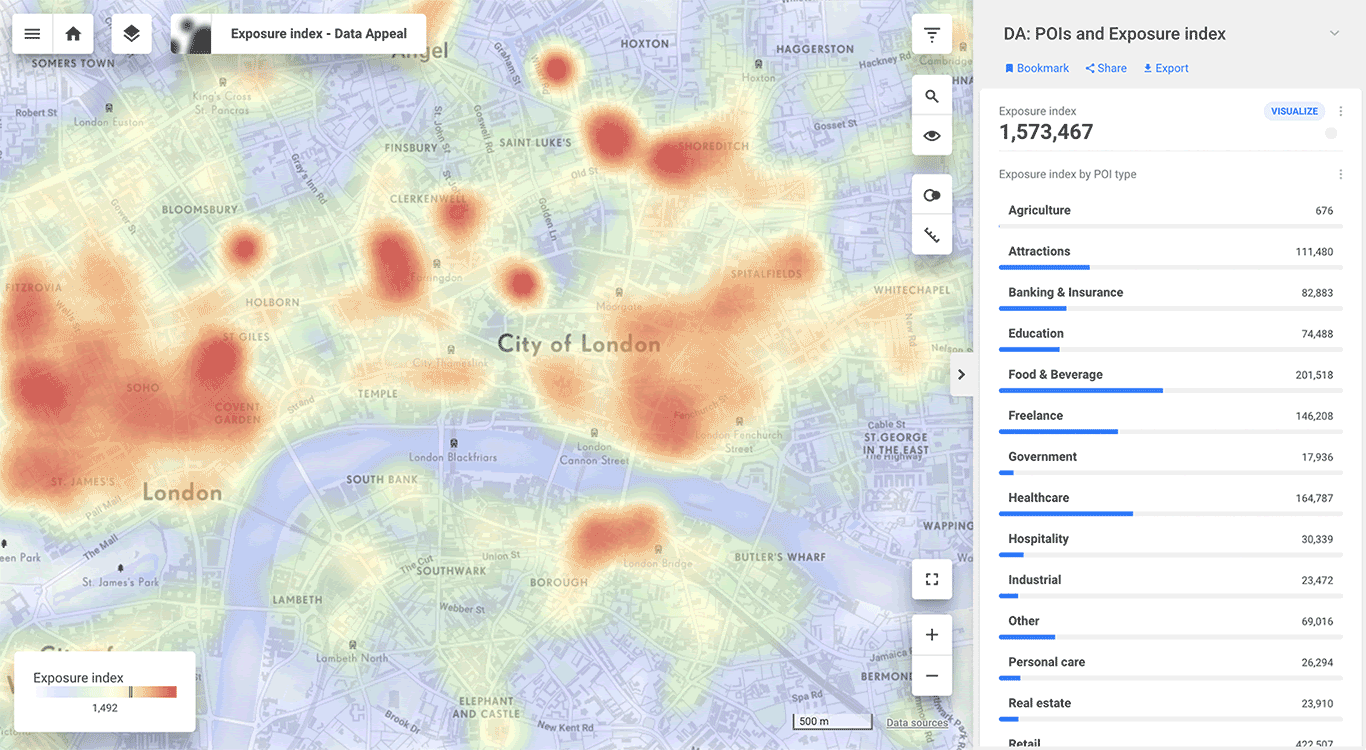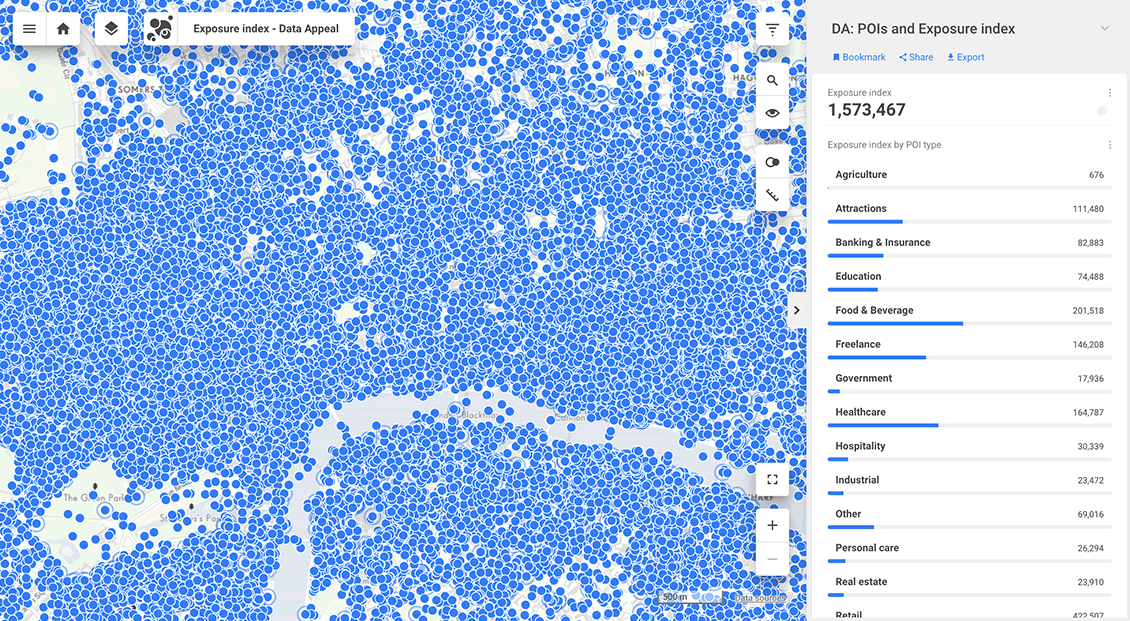Around the world, electric vehicle (EV) charging stations are popping up everywhere – from grocery stores and shopping malls to gas stations and fast food restaurants. Not only do EV chargers support green business initiatives and reduce the carbon footprint, they also help support a brands’ values and corporate social responsibility (CSR) commitments. The only question is, where should you install them to reap the maximum benefits?
Location Intelligence for EV charging stations
Location Intelligence is your secret weapon for strategic site selection and footprint optimization, especially when looking to save time and money. If you’re unfamiliar, location intelligence is the methodology of deriving insights from points of interest and ‘places’ data to answer spatial questions, such as:
- Where do I start expanding my brand or products, and how do I best position my products and services?
- Which areas are most frequented by my target audience? What time of day is foot traffic the highest and lowest?
- Where should I place outdoor media and advertising for my products?
- Which venues, distributors and territories should I focus on for site selection?
To define an effective growth strategy for a product launch, site selection or market evaluation, a meticulous analysis of the places and businesses in a selected territory is necessary.
Strategically position EV chargers to maximize usability
For EV charger organizations, pinpointing the most strategic spots and neighbourhoods across any city, region or country is critical. Should you place EV chargers near gyms, supermarkets and cafes to catch the 1-hour parkers, offices and co-working spaces for the daily commuters or perhaps near gas stations for those with just a few minutes to spare?
Before selecting the location, you must first determine your target market:
- Who uses my EV charging stations and where do they typically go during the day?
Once that’s determined, you then need to assess a territory to uncover:
- Which areas are the most popular and at what peak times?
- Which places record the most satisfied customers, or conversely, the most customer complaints?
- Is my existing installment base meeting the needs of customers? Does the service require maintenance or replacement?
As EV charging stations pop up across cities, business developers will know that it’s not easy to penetrate new markets, increase brand awareness and develop local marketing activation. However, by deeply understanding the dynamics of a territory, you can identify the areas with the most potential.
Spatial Analysis made simple, thanks to CleverMaps
For this evaluation, we turned to our partners at CleverMaps, a leading Location Intelligence platform enabling businesses to get actionable insights for their decisions through spatial analysis.
With the UK at the forefront of EV chargers, CleverMaps integrated our data from the city center of London onto their platform. In total, we detected 150,261 points of interest from 20 industries and over 800 categories.

Fig. 1 Showing all 150,261 Points of Interest in London, UK sorted into industries
Explore some screenshots from an interactive Location Intelligence map to pinpoint local activation sites in the center of London, England.
The map contains:
- Over 150,000 points of interest with quantitative and qualitative information (name, address, contact information, Sentiment Score, Popularity Index, etc.)
- Filters to select POIs by industry, subcategory, Sentiment Score, etc.
- Filters to assess the popularity of neighborhoods and businesses (popularity and popularity heatmap)
- Peak Periods – which time of day is the busiest/slowest for each business
- CleverMaps’ Exposure Index (see the animation below), the perfect tool to measure the potential of any location based on the surrounding Points of Interest.

Fig. 2 Exposure Index curated from Data Appeal points of interest data visualized in the CleverMaps platform
Optimal Site Selection based on Sentiment and Popularity
Based on a Location Intelligence approach, let’s explore the site selection possibilities by leveraging the map below.
By dividing points of interest into industries and subcategories, we can easily filter them based on our criteria. In this case, we are targeting the 1-hour parkers visiting gyms, supermarkets, and cafes so we set the filters in CleverMaps accordingly.
As a result, we visualize all the selected POIs on a dot map that also reflects the related Sentiment Score and Popularity Index – the bigger the dot, the higher values of both.

Fig. 3 Filtering the relevant points of interest in the CleverMaps platform
So, how do we decide where to place our EV chargers? We can continue narrowing down the selection by changing the visualization to the grid view from this point.
We want to place our EV chargers close to the locations with the highest Sentiment Score and Popularity Index, so we filter out anything below 90.
The final visualization shows us all the grids in London matching our criteria, and on the dashboard, we have the final rating of the grid available.

Fig. 4 Narrowing down the site selection by filtering the location sentiment score
This Location Intelligence site selection approach helps us identify the most frequented sites by our target market with the highest Popularity Index and Sentiment Score over the past two years.
How to turn data points into concrete actions?
Once a customer’s desired analysis is conducted, the data is used to:
- Analyze the places with the highest investment potential for effective site selection
- Seamlessly qualify distributors by accessing the POI address and contact information
- Evaluate current product coverage compared against competitors
- Identify the best areas for outdoor advertising or out-of-home marketing campaigns and events
Unlike a standard data analysis, which offers static data and one-time results, Location Intelligence and real-time data provide dynamic and continuously updated analyses and forecasts.
Moreover, the data provides users with actionable insights, thanks to interactive maps, like the one above. With these insights, new ideas can emerge, new investment opportunities are discovered and new competitors are considered.



